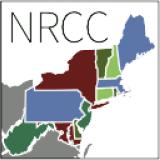The pre-drought footprint expands, raising awareness of the possible return of drought conditions.
For more details, see the Northeast Drought Early Warning System Dashboard.
Key Points
- Abnormally dry (D0) conditions returned to portions of western New York and along the New England coast from Connecticut to Maine. Growing precipitation deficits since March were exacerbated by little rainfall so far this May.
- Moderate drought (D1) held fast in northwest Maine.
- Abnormally dry (D0) conditions surrounding Maine’s D1 saw both improvement and degradation with spotty precipitation patterns during the last few weeks
- Abnormally dry (D0) conditions remained in northern Vermont and small portions of northern New Hampshire.
Current U.S. Drought Monitor map for the Northeast Drought Early Warning System with data valid for May 17, 2022. The U.S. Drought Monitor is updated each Thursday to show the location and intensity of drought across the country.
According to the latest U.S. Drought Monitor:
- Moderate drought (D1) conditions exist in 1.51% of the region.
- Abnormally dry (D0) conditions exist in 19.48% of the region.
U.S. Drought Monitor Categories
Current U.S. Drought Monitor map for the Northeast Drought Early Warning System with data valid for May 17, 2022. The U.S. Drought Monitor is updated each Thursday to show the location and intensity of drought across the country.
According to the latest U.S. Drought Monitor:
- Moderate drought (D1) conditions exist in 1.51% of the region.
- Abnormally dry (D0) conditions exist in 19.48% of the region.
Current Conditions
U.S. Drought Monitor 4-Week Change Map

Animation: 2022 U.S. Drought Monitor Conditions in the Northeast

Accumulated Precipitation Departure from Normal

Potential Evapotranspiration (PET) Departure from Normal
Unseasonably warm temperatures just before mid-month resulted in PET rates that exceeded the normal seasonal progression in Buffalo and Caribou, and to a somewhat lesser extent, Boston. These large increases were not observed in New York City, where cooler temperatures prevailed. There is potential for increased PET rates this weekend (May 21–22, 2022) due to forecasts for excessively warm temperatures in much of southern New England.

State-Reported Impacts
Maine
- May 8, 2022: Maine Public – A new state grant program
- May 10, 2022: WGAN – Maine blueberries bounce back in 2021 after drought impacts in 2020
- May 11, 2022: The Ellsworth American – Outlook for 2022 blueberry crop
Massachusetts
- May 1, 2022: CBS Boston – Blue Hills Reservation fire
- May 5, 2022: Haverhill Gazette – Wind-driven fire drought related?
- May 11, 2022: "State Officials Urge Water Conservation after Declaring Drought in Southeast, Islands Regions"
- May 12, 2022: Martha's Vineyard Times – Martha’s Vineyard is experiencing "mild drought", sharing water conservation and preparedness guidance for individuals and communities
- May 13, 2022: The Berkshire Edge – "Wildfire Alerts Issued Across Massachusetts After 10 Days of Dry Conditions"
New Hampshire
- May 18, 2022: WMUR – White Mountain National Forest – Crawford Notch fire
New York
- May 17, 2022: New York Department of Environmental Conservation (DEC) – Recent Statewide Forest Ranger Actions
* Please note: Nomenclature for drought levels varies between states and agencies. For detailed descriptions of drought status levels, please see the issuing agency's website.
What We Are Watching
Heatwaves and Drought in the Northeast
During the April NOAA Eastern Region Climate Services webinar, Mathew Barlow and Laurie Agel highlighted some of the findings from their research funded by the NOAA Climate Program Office's Modeling, Analysis, Predictions and Projections (MAPP) Program.
View the presentation video (start time 13:49) and slide sets, or read their paper in Nature.
Heat, Health, and Drought
Don’t forget to register for the next NOAA Eastern Region Climate Services webinar on Thursday, May 26, focused on "Heat, Health, and Drought." Use that same link to register for other webinars through the summer (July 28 and August 30).
Evaporative Demand Increase Across Lower 48 Means Less Water Supplies, Drier Vegetation, and Higher Fire Risk
A recent NIDIS-funded study, led by the Desert Research Institute, found that evaporative demand has increased across much of the U.S. over the past 40 years and is emerging outside the range of what was experienced just 20–40 years ago in some places. Learn more.
Outlooks
- According to the Climate Prediction Center's 8–14 day outlook (valid May 27–June 2), the entire Northeast is more likely to see above-normal temperatures and near-normal precipitation.
- The week 3–4 outlooks (valid May 28–June 10) favor above-normal temperatures throughout most of the Northeast, except far-western New York. The entire region has equal chances of above- or below-normal precipitation.
8–14 Day Temperature Outlook

8–14 Day Precipitation Outlook

Temperature Outlook Week 3–4

Precipitation Outlook Week 3–4

Additional Resources
New on the Northeast DEWS Dashboard
- Northeast DEWS Dashboard: U.S. Geological Survey streamflow and groundwater status maps now have pop out capability to view site-specific information.
Other Resources
- VIC Soil Moisture
- New NRCC SPI Maps
- Your local National Weather Service office
- NOAA Regional Climate Services Monthly Webinar Series (next webinar is on May 26)
- USDA Northeast Climate Hub
- USGS New England and New York Water Science Centers
Use these sites to keep tabs on drought degradation and improvements in the areas outside of the Northeast DEWS borders:
Contacts for More Information
Sylvia Reeves
Regional Drought Information Coordinator (Northeast DEWS)
NOAA/CIRES/National Integrated Drought Information System (NIDIS)
Email: sylvia.reeves@noaa.gov
Ellen L. Mecray
Regional Climate Services Director, Eastern Region
NOAA/NESDIS/National Centers for Environmental Information
Email: Ellen.L.Mecray@noaa.gov
Prepared By
Sylvia Reeves
NOAA/National Integrated Drought Information System (NIDIS), CIRES
Samantha Borisoff, Jessica Spaccio, Keith Eggleston, Art DeGaetano
Northeast Regional Climate Center
Ellen Mecray
Regional Climate Services Director, Eastern Region, NOAA
David Hollinger and Maria Janowiak
USDA Climate Hubs
Gardner Bent
USGS New England Water Science Center
In partnership with National Weather Service Offices of the Northeast and State Climate Offices of the Northeast.
This drought early warning update is issued in partnership between the National Oceanic and Atmospheric Administration (NOAA), U.S. Geological Survey, and the U.S. Department of Agriculture (USDA) to communicate concern for drought expansion and intensification within the Northeast U.S. based on recent conditions and the forecasts and outlooks. NIDIS and its partners will issue future Drought Early Warning Updates as conditions evolve.






